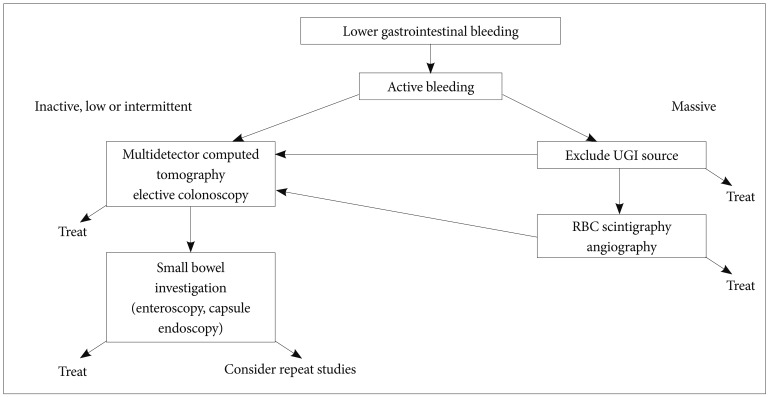Clin Endosc.
2013 Sep;46(5):476-479.
Lower Gastrointestinal Bleeding: Is Urgent Colonoscopy Necessary for All Hematochezia?
- Affiliations
-
- 1Department of Internal Medicine, Yeungnam University College of Medicine, Daegu, Korea. jbi@med.yu.ac.kr
Abstract
- Lower gastrointestinal bleeding (LGIB) is defined as acute or chronic abnormal blood loss distal to the ligament of Treitz. The incidence of LGIB is only one fifth of that of the upper gastrointestinal tract and is estimated to be 21 to 27 cases per 100,000 adults per year. Acute bleeding is arbitrarily defined as bleeding of <3 days' duration resulting in instability of vital signs, anemia, and/or need for blood transfusion. Chronic bleeding is defined as slow blood loss over a period of several days or longer presenting with symptoms of occult fecal blood, intermittent melena, or scant hematochezia. Bleeding means that the amounts of blood in the feces are too small to be seen but detectable by chemical tests. LGIB is usually chronic and stops spontaneously. Bleeding stop (80%), but male gender and older patients suffer from more severe LGIB. The optimal timing of colonoscopic intervention for LGIB remains uncertain. Urgent colonoscopy may serve to decrease hospital stay. However, urgent colonoscopy is difficult to control, and showed no evidence of improving clinical outcomes or lowering costs as compared with routine elective colonoscopy.
Keyword
MeSH Terms
Figure
Reference
-
1. Longstreth GF. Epidemiology and outcome of patients hospitalized with acute lower gastrointestinal hemorrhage: a population-based study. Am J Gastroenterol. 1997; 92:419–424. PMID: 9068461.2. Bramley PN, Masson JW, McKnight G, et al. The role of an open-access bleeding unit in the management of colonic haemorrhage. A 2-year prospective study. Scand J Gastroenterol. 1996; 31:764–769. PMID: 8858744.
Article3. Zuckerman GR, Prakash C, Askin MP, Lewis BS. AGA technical review on the evaluation and management of occult and obscure gastrointestinal bleeding. Gastroenterology. 2000; 118:201–221. PMID: 10611170.
Article4. Strate LL. Lower GI bleeding: epidemiology and diagnosis. Gastroenterol Clin North Am. 2005; 34:643–664. PMID: 16303575.
Article5. Jensen DM, Machicado GA, Jutabha R, Kovacs TO. Urgent colonoscopy for the diagnosis and treatment of severe diverticular hemorrhage. N Engl J Med. 2000; 342:78–82. PMID: 10631275.
Article6. Ohyama T, Sakurai Y, Ito M, Daito K, Sezai S, Sato Y. Analysis of urgent colonoscopy for lower gastrointestinal tract bleeding. Digestion. 2000; 61:189–192. PMID: 10773724.
Article7. Strate LL, Syngal S. Timing of colonoscopy: impact on length of hospital stay in patients with acute lower intestinal bleeding. Am J Gastroenterol. 2003; 98:317–322. PMID: 12591048.
Article8. García Sánchez M, González Galilea A, López Vallejos P, et al. Role of early colonoscopy in severe acute lower gastrointestinal bleeding. Gastroenterol Hepatol. 2001; 24:327–332. PMID: 11481066.9. Chaudhry V, Hyser MJ, Gracias VH, Gau FC. Colonoscopy: the initial test for acute lower gastrointestinal bleeding. Am Surg. 1998; 64:723–728. PMID: 9697900.10. Kok KY, Kum CK, Goh PM. Colonoscopic evaluation of severe hematochezia in an Oriental population. Endoscopy. 1998; 30:675–680. PMID: 9865555.
Article11. Angtuaco TL, Reddy SK, Drapkin S, Harrell LE, Howden CW. The utility of urgent colonoscopy in the evaluation of acute lower gastrointestinal tract bleeding: a 2-year experience from a single center. Am J Gastroenterol. 2001; 96:1782–1785. PMID: 11419829.
Article12. Richter JM, Christensen MR, Kaplan LM, Nishioka NS. Effectiveness of current technology in the diagnosis and management of lower gastrointestinal hemorrhage. Gastrointest Endosc. 1995; 41:93–98. PMID: 7721024.
Article13. Jensen DM, Machicado GA. Colonoscopy for diagnosis and treatment of severe lower gastrointestinal bleeding. Routine outcomes and cost analysis. Gastrointest Endosc Clin N Am. 1997; 7:477–498. PMID: 9177148.
Article14. Green BT, Rockey DC, Portwood G, et al. Urgent colonoscopy for evaluation and management of acute lower gastrointestinal hemorrhage: a randomized controlled trial. Am J Gastroenterol. 2005; 100:2395–2402. PMID: 16279891.
Article15. Laine L, Shah A. Randomized trial of urgent vs. elective colonoscopy in patients hospitalized with lower GI bleeding. Am J Gastroenterol. 2010; 105:2636–2641. PMID: 20648004.
Article16. Kollef MH, Canfield DA, Zuckerman GR. Triage considerations for patients with acute gastrointestinal hemorrhage admitted to a medical intensive care unit. Crit Care Med. 1995; 23:1048–1054. PMID: 7774215.
Article17. Laine L. Acute and chronic gastrointestinal bleeding. In : Feldman M, Sleisenger MH, Scharschmidt BF, Klein S, editors. Sleisinger's & Fordtran's Gastrointestinal and Liver Disease. 6th ed. Philadelphia: Saunders;1998. p. 198–219.18. Vernava AM 3rd, Moore BA, Longo WE, Johnson FE. Lower gastrointestinal bleeding. Dis Colon Rectum. 1997; 40:846–858. PMID: 9221865.
Article19. Zuckerman GR, Prakash C. Acute lower intestinal bleeding. Part II: etiology, therapy, and outcomes. Gastrointest Endosc. 1999; 49:228–238. PMID: 9925703.20. Winkler R. Ursachen und Klinik der peranalen Blutung. In : Häring R, editor. Gastrointestinalem Blutung. Berlin: Blackwell;1990. p. 313–319.
- Full Text Links
- Actions
-
Cited
- CITED
-
- Close
- Share
- Similar articles
-
- Hematochezia due to Angiodysplasia of the Appendix
- Clinical assessment and treatment algorithm for lower gastrointestinal bleeding
- The 3 cases of colonic diverticular bleeding treated by colonoscopic hemostatic procedures
- Massive Lower Gastrointestinal Bleeding from the Appendix
- A Case of Colonic Angiodysplasia in Massive Lower Gastrointestinal Bleeding


